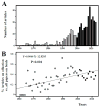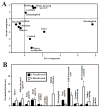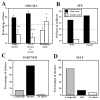The perfume of reproduction in birds: chemosignaling in avian social life
- PMID: 24928570
- PMCID: PMC4263688
- DOI: 10.1016/j.yhbeh.2014.06.001
The perfume of reproduction in birds: chemosignaling in avian social life
Abstract
This article is part of a Special Issue "Chemosignals and Reproduction". Chemical cues were probably the first cues ever used to communicate and are still ubiquitous among living organisms. Birds have long been considered an exception: it was believed that birds were anosmic and relied on their acute visual and acoustic capabilities. Birds are however excellent smellers and use odors in various contexts including food searching, orientation, and also breeding. Successful reproduction in most vertebrates involves the exchange of complex social signals between partners. The first evidence for a role of olfaction in reproductive contexts in birds only dates back to the seventies, when ducks were shown to require a functional sense of smell to express normal sexual behaviors. Nowadays, even if the interest for olfaction in birds has largely increased, the role that bodily odors play in reproduction still remains largely understudied. The few available studies suggest that olfaction is involved in many reproductive stages. Odors have been shown to influence the choice and synchronization of partners, the choice of nest-building material or the care for the eggs and offspring. How this chemical information is translated at the physiological level mostly remains to be described, although available evidence suggests that, as in mammals, key reproductive brain areas like the medial preoptic nucleus are activated by relevant olfactory signals. Olfaction in birds receives increasing attention and novel findings are continuously published, but many exciting discoveries are still ahead of us, and could make birds one of the animal classes with the largest panel of developed senses ever described.
Keywords: Avian; Olfaction; Pheromone; Sexual selection recognition.
Copyright © 2014 Elsevier Inc. All rights reserved.
Figures







Similar articles
-
Pheromones in birds: myth or reality?J Comp Physiol A Neuroethol Sens Neural Behav Physiol. 2010 Oct;196(10):751-66. doi: 10.1007/s00359-010-0534-4. Epub 2010 May 21. J Comp Physiol A Neuroethol Sens Neural Behav Physiol. 2010. PMID: 20490809 Free PMC article. Review.
-
The underestimated role of olfaction in avian reproduction?Behav Brain Res. 2009 Jun 25;200(2):248-59. doi: 10.1016/j.bbr.2008.08.036. Epub 2008 Sep 2. Behav Brain Res. 2009. PMID: 18804490 Free PMC article. Review.
-
Processing by the main olfactory system of chemosignals that facilitate mammalian reproduction.Horm Behav. 2015 Feb;68:53-64. doi: 10.1016/j.yhbeh.2014.06.003. Epub 2014 Jun 12. Horm Behav. 2015. PMID: 24929017 Review.
-
D'scent of man: a comparative survey of primate chemosignaling in relation to sex.Horm Behav. 2015 Feb;68:117-33. doi: 10.1016/j.yhbeh.2014.08.001. Epub 2014 Aug 10. Horm Behav. 2015. PMID: 25118943 Review.
-
Individual odor recognition in procellariiform chicks: potential role for the major histocompatibility complex.Ann N Y Acad Sci. 2009 Jul;1170:442-6. doi: 10.1111/j.1749-6632.2009.03887.x. Ann N Y Acad Sci. 2009. PMID: 19686174
Cited by
-
Can house sparrows recognize familiar or kin-related individuals by scent?Curr Zool. 2019 Feb;65(1):53-59. doi: 10.1093/cz/zoy018. Epub 2018 Mar 7. Curr Zool. 2019. PMID: 30697238 Free PMC article.
-
Feather chemicals contain information about the major histocompatibility complex in a highly scented seabird.Proc Biol Sci. 2022 May 25;289(1975):20220567. doi: 10.1098/rspb.2022.0567. Epub 2022 May 25. Proc Biol Sci. 2022. PMID: 35611538 Free PMC article.
-
Sight or smell: which senses do scavenging raptors use to find food?Anim Cogn. 2019 Jan;22(1):49-59. doi: 10.1007/s10071-018-1220-0. Epub 2018 Oct 26. Anim Cogn. 2019. PMID: 30367315 Free PMC article.
-
Olfactory Communication via Microbiota: What Is Known in Birds?Genes (Basel). 2018 Jul 31;9(8):387. doi: 10.3390/genes9080387. Genes (Basel). 2018. PMID: 30065222 Free PMC article. Review.
-
A brain for all seasons: An in vivo MRI perspective on songbirds.J Exp Zool A Ecol Integr Physiol. 2022 Dec;337(9-10):967-984. doi: 10.1002/jez.2650. Epub 2022 Aug 21. J Exp Zool A Ecol Integr Physiol. 2022. PMID: 35989548 Free PMC article. Review.
References
-
- Ables EM, Kay LM, Mateo JM. Rats assess degree of relatedness from human odors. Physiol Behav. 2007;90:726–732. - PubMed
-
- Allison AC. Morphology of olfaction in vertebrates. Biol Rev. 1953;28:195–244.
-
- Amo L, Aviles JM, Parejo D, Pena A, Rodriguez J, Tomas G. Sex recognition by odour and variation in the uropygial gland secretion in starlings. J Anim Ecol. 2012a;81:605–613. - PubMed
-
- Amo L, Galvan I, Tomas G, Sanz JJ. Predator odour recognition and avoidance in a songbird. Funct Ecol. 2008;22:289–293.
Publication types
MeSH terms
Substances
Grants and funding
LinkOut - more resources
Full Text Sources
Other Literature Sources

